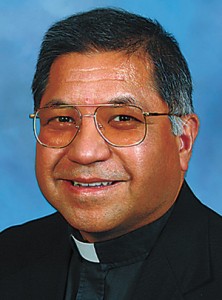By Fr. Rudolph Juarez

Once again I make my pilgrimage to the Basilica of Our Lady of Guadalupe. I leave the zócalo, or main square of Mexico City on a microbus. The eight-mile trip costs me 5 pesos — all of 35 American cents — and takes about 20 minutes because traffic is flowing well.
I make it a point to visit Guadalupe every time I am in Mexico City (which is a lot according to my staff). Yet, I am drawn to her, like so many of the Mexicans and pilgrims who come to see her, drawn by filial affection and the desire to pray and say to her: “Once again holy Mother, I kneel before you.”
It is October and her feast day isn’t until Dec. 12, but already the basilica is crowded at 8:20 in the morning due to the fact that the cardinal of Mexico City will be presiding at Mass. Built in the round, the roof of the Basilica looks like a giant mantle, symbolic of the protective mantle of Guadalupe — under which all of her children can gather.
Making my way to the moving walkways beneath the tilma (St. Juan Diego’s actual cloak on which the Blessed Mother left her image), I see the 46 stars on her heavenly blue mantle. These are in accord with the constellation of the stars over Mexico that winter of 1531. I think to myself: “Soon, back home in Columbus Junction, they will be praying 46 rosaries – one for each star, in preparation for her feast day!”
Ah, such devotion!
And yet, this is the kind of devotion Guadalupe evokes from the faithful, and even not so faithful. For while the foothill of Tepeyac was the site where Our Lady first appeared 482 years ago on this date, her image is found throughout the world and most importantly enshrined in the hearts of people from all walks of life: from nuns to taxi cab drivers to executives to non-believers, to prisoners who tattoo her image on their bodies.
This reach across time and across social, racial and continental borders never ceases to amaze me, considering that as a boy attending parochial school in Davenport in the 1960s I didn’t know much of the story of Guadalupe, who gave the humble peasant Juan Diego roses to give to the bishop of Mexico as proof of her apparition and person. Or, that it was she, who through this sign of roses, left her image painted on Juan Diego’s cloak and requested to have a church built in honor of the one true God “in whom we live and move and have our being,” wherein she could show her maternal love and care for all.
I am almost ready to leave the basilica now. I have prayed for my parishioners, for my godson (who needs a lot of prayers), and everyone else I can think of to pray for. As I leave, pilgrims keep streaming in, and I hear the familiar words of the Marian hymns we sing in honor of Guadalupe. Lost in the sea of pilgrims, I am happy, very happy — to be counted among those who come to rejoice with Mary and in the one true God “in whom we live and move and have our being.”
For I know, that in the early morning of Dec. 12, I will be back in my parish, surrounded by other pilgrims who find themselves in Iowa. And, there, before the image of the Blessed Mother in filial affection and straight from the heart, I will whisper my prayer: “Once again holy Mother, I kneel before you.”
(Fr. Juarez is pastor of St. Patrick Parish in Iowa City.)







